| |
Effect of baseline protease genotype & phenotype on HIV response to atazanavir/ritonavir & lopinavir/r in treatment-experienced patients, study 045
|
| |
| |
AIDS: Volume 20(6) 4 April 2006 p 847-853
Naeger, Lisa K; Struble, Kimberly A
From the Division of Antiviral Products, Center for New Drug Evaluation, Food and Drug Administration, Silver Spring, Maryland, USA.
These views represent the authors' opinion and not necessarily the views of the Food and Drug Administration.
This paper describes the FDA's analyses of virologic response based on baseline genotype and phenotype of treatment-experienced patients in Bristol-Myers Squibb (BMS)-sponsored Study AI424045...given the current availability of resistance testing in clinical practice and the need to disseminate resistance information to health care providers, comprehensive resistance testing should be undertaken in all phases of drug development with an emphasis on earlier stages of development....The recommended dose in antiretroviral-naive HIV-infected patients is 400 mg given orally once daily with food [9]. An alternative dosing regimen of ATV/RTV 300/100 mg once daily with food is recommended for antiretroviral treatment-experienced, HIV-infected patients...
ABSTRACT
Objectives: To assess the virologic response rates of atazanavir/ritonavir and lopinavir/ritonavir based on baseline genotype and phenotype.
Methods: Resistance analyses were performed on a Bristol-Myers Squibb-sponsored study comparing the safety and efficacy of atazanavir/ritonavir to lopinavir/ritonavir in treatment-experienced subjects at 48 weeks. Analyses evaluated virologic response based on the presence of baseline primary protease inhibitor mutations and baseline susceptibility.
Results:
Less than 30% of atazanavir/ritonavir-treated patients were responders if substitutions at positions M46, G73, I84 or L90 were present in their HIV at baseline.
In comparison, lopinavir/ritonavir response rates were less than 30% when protease substitutions at M46, I54, or I84 were present at baseline.
The response rates were similar between atazanavir/ritonavir and lopinavir/ritonavir-treated subjects with zero to four baseline protease inhibitor mutations, but response rates were reduced if five or more baseline mutations were present: 0% for atazanavir/ritonavir compared with 28% for lopinavir/ritonavir.
Baseline phenotype results showed that response rates were similar between atazanavir/ritonavir and lopinavir/ritonavir if shifts in susceptibility were zero to five, but response rates were lower if shifts were greater than five; 11% for atazanavir/ritonavir compared with 27% for lopinavir/ritonavir.
Conclusions: Both type and number of baseline protease inhibitor mutations affected virologic response to atazanavir/ritonavir and lopinavir/ritonavir in treatment-experienced subjects. In addition, baseline phenotypic susceptibility could differentiate virologic response rates to the two drugs. These resistance analyses provide information on the likelihood of a virologic response to antiretroviral drugs based on baseline genotypic and phenotypic data, which is valuable to physicians and patients when choosing antiretroviral regimens.
RESULTS
Overall, the response rates in Study AI424045 at week 48 were comparable, with 55% of patients in the ATV/RTV group considered responders compared to 57% in the LPV/RTV arm [95% confidence interval (CI), (-16.7, 12.4) [2,4]. The proportion of patients with HIV RNA < 50 copies/ml was 38% for ATV/RTV versus 45% for LPV/RTV (95% CI, -21.5, 7.3).
Virologic response based on type of baseline mutations in antiretroviral-experienced patients
Analyses were conducted to evaluate HIV RNA response according to the presence or absence of baseline PI mutations. The PI mutations used in this analysis included any change at PI resistance-associated amino acid positions D30, V32, M36, M46, I47, G48, I50, I54, A71, G73, V77, V82, I84, N88, and L90. These mutations were selected from various publications and are associated with reduced susceptibility to currently approved PIs [10-12].
Response rates were decreased compared to the overall population for both ATV/RTV and LPV/RTV if a M46I, I54V/L/M, A71V/T/I, G73S/A/C, V82A/F/T/S/I or I84V mutation was present at baseline (Table 1). Insufficient data (n < 3) were available for PI mutations V32I, I47V, G48V, I50V and F53L to reach a conclusion regarding the impact of these mutations on virologic outcome. There were no isolates at the start of this study that contained the I50L mutation, an ATV resistance-associated mutation. Less than 30% of ATV/RTV-treated patients were responders if they had substitutions at M46, G73, I84 or L90 in their HIV at baseline. In comparison, LPV/RTV response rates were < 30% when protease substitutions at M46, I54, or I84 were present at baseline. Response rates differed between ATV/RTV and LPV/RTV when the L90M mutation was present at baseline with 23% of patients in the ATV/RTV responding at week 48 compared to 50% in the LPV/RTV group. The presence of the D30N, M36I/V, V77I, and N88S/D mutations at baseline did not appear to affect response to ATV/RTV.
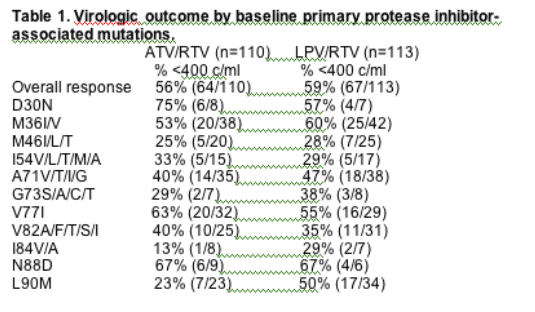
Virologic response based on number of baseline PI mutations in antiretroviral-experienced patients
To determine virologic response based on the number of baseline PI mutations, any change at amino acid positions D30, V32, M36, M46, I47, G48, I50, F53, I54, A71, G73, V77, V82, I84, N88 and L90 present at baseline was counted for each patient isolate. We conducted analyses to assess incrementally by various groupings how the number of baseline PI mutations affected virologic response (Table 2). Then, the results were reviewed to determine the number of baseline mutations that were associated with maximal, reduced or minimal response. For patients with zero to two PI resistance-associated mutations at baseline, response rates were similar (75%) for both treatment groups. Response rates for both treatment groups declined from > 60% to < 40% when three or more mutations of these PI mutations were present at baseline. However, 0% (0/8) patients in the ATV/RTV group were responders if five or more primary PI mutations were present at baseline compared with 28% (5/18) in the LPV/RTV group. The proportion of subjects with HIV RNA < 50 copies/ml is also shown in Table 2.
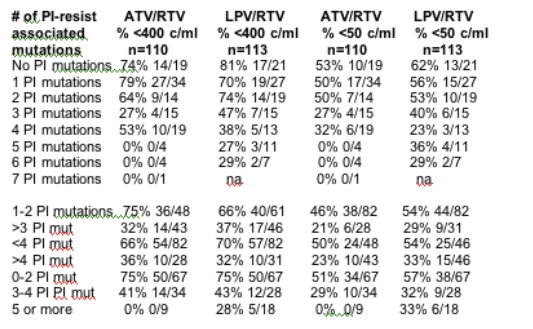
Virologic response based on both number and type of baseline mutations
We conducted analyses to determine if the number of PI mutations including a specific baseline PI mutation adversely affected virologic outcome.
In general, response rates were not adversely affected if one or two baseline PI mutations were present, irrespective of the specific baseline mutation. However, in the ATV/RTV group, response rates were < 30% in patients with three or more primary baseline PI mutations including M36I, M46I/V/L or V82A/F/T/S and < 20% in patients with three or more primary baseline PI mutations including G73S/A/C, I84V or L90M (Table 3, italicized). The response rates for the LPV/RTV group were < 30% if three or more PI mutations including substitutions at M46 or V82 were present at baseline (Table 3, italicized).
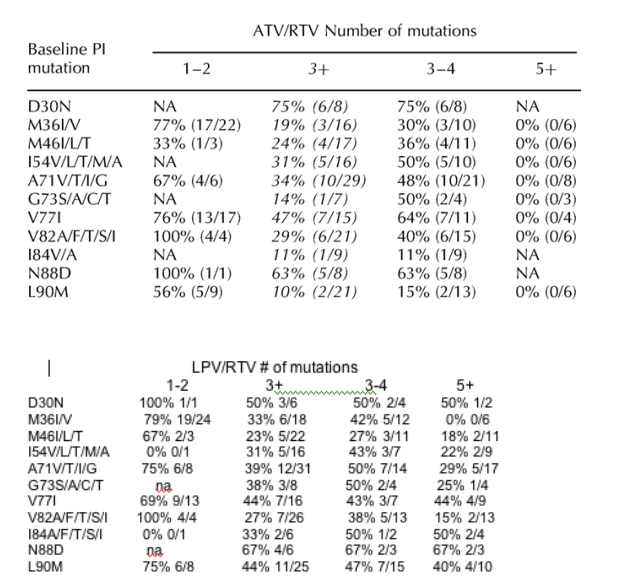
The L90M mutation appeared to only adversely affect ATV/RTV virologic outcome if present with a total of three or more PI mutations. Response rates were similar for the overall population (58%) and ATV/RTV-treated patients with one or two PI mutations including the L90M mutation (56%); however, the response rate was reduced to 10% if the three or more baseline PI mutations including the L90M mutation were present (Table 3). This finding was not apparent in the first analysis of response rates by type of baseline PI mutation where 23% of ATV/RTV-treated patients were classified as responders if baseline HIV included the L90M mutation. Similarly, we found low response rates for ATV/RTV-treated patients who had three or more PI mutations at baseline that included a mutation at position M36, V71 or V82.
The response rates were also decreased in the LPV/RTV group in patients with three or more baseline PI mutations including substitutions at M36, M46, I54, A71, G73, or V82 compared to patients with one or two baseline PI mutations including these same substitutions (Table 3). A table describing these data is included in the ATV package insert [9].
Outcome based on baseline phenotype in antiretroviral-experienced patients
The virologic response rates were also analyzed by baseline phenotype (shift in in-vitro susceptibility relative to reference) in an attempt to determine baseline phenotypic susceptibility breakpoints relevant to both ATV/RTV and LPV/RTV. First, response rates for each treatment group were analyzed by median baseline phenotype, quartiles and tertiles (Table 4). Next, several alternative baseline phenotype ranges using an incremental approach were explored to examine response rates by baseline susceptibility. Based on the results, we determined the baseline phenotype ranges 0-2, > 2-5, > 5-10 and > 10 that best described the data for both treatment groups. The phenotypic assay variability of approximately two-fold was considered when the four baseline phenotypic ranges were determined. Response rates were similar between the ATV/RTV and LPV/RTV treatment groups in patients with a five-fold or less shift in susceptibility compared with the reference; whereas, response rates differed between the two treatment groups for baseline phenotype greater than five-fold (Table 4; Fig. 1). In ATV/RTV-treated patients with a baseline phenotype of between five and 10 and greater than 10, response rates were 13 and 10%, respectively, in comparison with 33 and 23%, respectively, for LPV/RTV-treated patients (Table 4; Fig. 1).
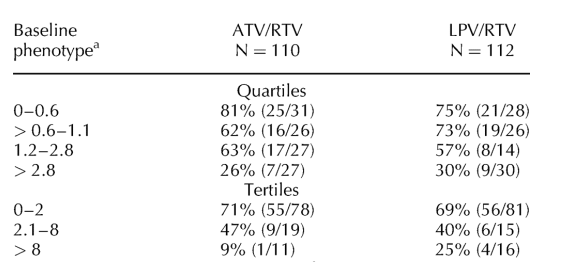
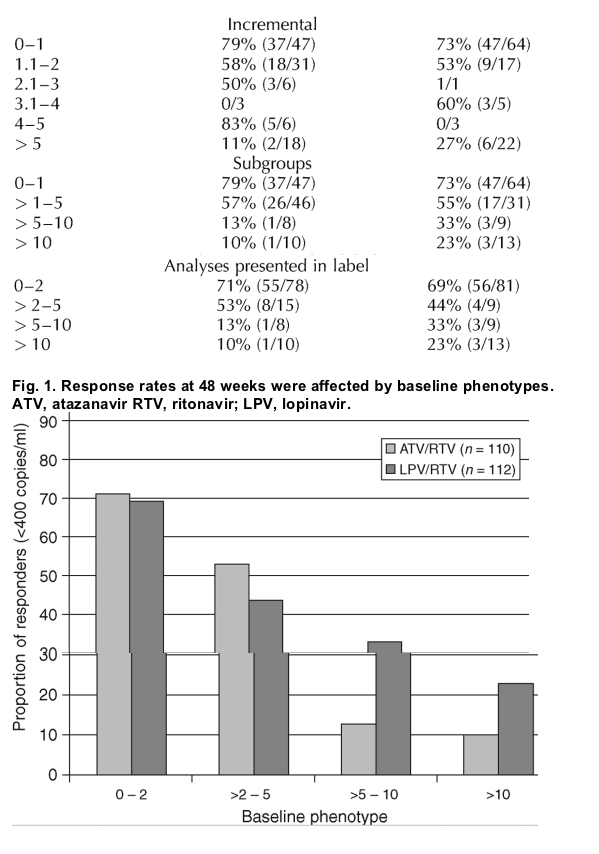
Discussion
Resistance testing has become an important tool in the clinical management of patients with HIV infection and thus has become a critical component in antiretroviral drug development. Genotypic and/or phenotypic analysis of baseline virus can aid in determining whether an antiretroviral drug has the potential to be an active component of a regimen before initiation of therapy in an HIV-infected patient. The Division of Antiviral Products at the FDA performs several types of resistance analyses using available HIV resistance data during the review of anti-HIV drugs. This information is valuable for physicians selecting antiretroviral drugs for patients with existing mutations in their HIV and reduced susceptibility to other antiretroviral drugs.
Baseline genotype and virologic response analyses assess relationships between a specific mutation or mutational pattern and virologic response to an antiretroviral drug. In our resistance analyses, a response rate less than 30% was observed in ATV/RTV-treated patients who had viruses with baseline protease amino acid substitutions at M46, G73, I84 or L90. Similarly, a response rate less than 30% was seen in patients receiving LPV/RTV if substitutions at M46, I54, or I84 were present at baseline. Response rates were numerically greater for LPV/RTV compared to ATV/RTV when L90 was present at the start of the study.
In addition, an increasing number of mutations at protease amino acid positions 30, 32, 36, 46, 47, 48, 50, 53, 54, 71, 73, 77, 82, 84, 88, 90 were associated with lower response rates. Response rates declined as the number of baseline PI mutations increased. Response rates were similar between ATV/RTV and LPV/RTV-treated patients with zero to two resistance-associated PI mutations at baseline, whereas response rates were reduced if three to four or five or more resistance-associated mutations were present at baseline. Response rates were numerically greater for patients who received LPV/RTV compared with ATV/RTV with five or more mutations at the start of the study. No patients in the ATV/RTV group were responders if five or more mutations were present at baseline compared with 28% in the LPV/RTV group.
The combination of the number of baseline PI mutations and the specific type of baseline PI mutation further distinguished response rates. For example, although the overall response rate in ATV/RTV-treated patients with M36 substitutions was 53%, the response rate was only 19% if three or more baseline PI mutations including M36 substitutions were present. In our analysis, ATV/RTV response rates were reduced to less than 30% if three or more baseline PI mutations including changes at amino acid positions M36, M46, G73, V82, I84, or L90 were present. Similarly, LPV/RTV response rates were reduced to less than 30% if three or more PI mutations including changes at M46 or V82 were present at baseline; however, if the M46 or V82 changes were present in the context of less than three baseline PI mutations, the response rates to LPV/RTV were 67 and 100%, respectively. Baseline substitutions at I54 and I84 appeared to adversely affect LPV/RTV response rates regardless of the number of baseline PI mutations.
Similar approaches using number and type of baseline PI mutations were recently presented in two studies that also evaluated the PI mutations associated with a reduced response to ATV/RTV in PI-experienced patients. In one study, a strong association with reduced virologic response was found with the combination of 10F/I/V, 16E, 33I/F/V, 46I/L, 60E, 84V, and 85V. Using these seven mutations, the virologic response was 100, 80, 42, and 0% in patients with zero or one, two, three and four or more mutations, respectively [13]. In a second study, the presence of PI mutations L10I, K20R, M46I/L, 54L/T/V, and L90M were associated with virologic failure to ATV/RTV [14]. Even though these studies were in different PI-experienced populations and different patterns of PI mutations were used in the analyses, the results are consistent with our results showing that changes at M46, I54, I84 and L90 are associated with reduced response rates to ATV/RTV and that ATV/RTV response rates decline in patients with three or more baseline PI mutations.
Overall, the FDA analysis did not differ significantly from the sponsor's submitted analysis. The sponsor has presented that the magnitude of response was inversely related to the number of baseline PI mutations, with a greater mean reduction in HIV RNA in patients with fewer than four PI mutations (at positions 10, 20, 24, 33, 36, 46, 48, 54, 63, 71, 73, 82, 84, or 90) compared with those with four or more PI mutations [15]. They also report that there was comparable efficacy between the ATV/RTV and LPV/RTV regimens for subgroups with less than four and four or more PI mutations. Our analysis showed similar findings for a cutoff of four PI mutations (See Table 2), but we report a decrease in response for ATV/RTV in patients with five or more PI mutations.
Response rates were also differentiated by baseline phenotype. Response rates were similar between ATV/RTV and LPV/RTV in patients whose baseline isolates displayed shifts in susceptibility of zero- to five-fold relative to the wild-type reference. Response rates were numerically lower in the ATV/RTV group compared to the LPV/RTV group in patients with shifts in susceptibility greater than five. Importantly, these analyses are based on a select patient population with 61% of subjects receiving an NNRTI-based regimen prior to study entry in comparison with 35% receiving a PI-based regimen. Thus, these baseline phenotype groups are not meant to represent definitive clinical susceptibility breakpoints for all patient populations. These data are provided to give clinicians information on the likelihood of virologic success based on pretreatment susceptibility to ATV/RTV versus LPV/RTV in PI-experienced subjects. Consistent with our results, in a recent report, a phenotypic clinical cutoff for ATV/RTV was defined as a baseline ATV fold change of 5.2 where the proportion with HIV RNA < 400 copies/ml was 77% for those with a baseline ATV fold change < 5.2 and 12% for those with a baseline ATV fold change ≥ 5.2 [16].
Following the complete review of the available data, the FDA in collaboration with the sponsor must concisely describe the critical results of the submitted studies and include the most relevant and useful information for patients and physicians in the package insert (drug label). We have outlined our general approach and explained our review process for baseline resistance and virologic response analyses. Initially, we looked at multiple incremental breakpoints and subgroups. We then used the totality of the data to determine meaningful subgroups. Rather than a single breakpoint for the number of baseline PI mutations or baseline phenotype, we prefer using incremental subgroups that represent maximal, reduced, or minimal response to treatment. For example, after an incremental approach examining response rates and baseline susceptibility in the baseline phenotype analysis, we concluded baseline phenotype ranges 0-2, > 2-5, > 5-10 and > 10 best described the data for both ATV/RTV and LPV/RTV. Response rates for the subgroups for maximal and reduced response in the baseline phenotypic analysis (Table 4) and the number of baseline PI mutations analysis (Table 2, italicized) were comparable. Consistent results across analyses lend further support to our approaches. However, confirmation with larger datasets is desirable to evaluate the robustness of these conclusions. In an effort to acquire more data on baseline genotype/phenotype relationships to virologic response, the Division regularly requests sponsors to provide additional data from Phase IV studies and continuing Phase III studies.
As a genotypic test could be used to aid in the decision to use ATV/RTV treatment, we decided to include the results of three or more primary PI mutations including specific PI mutations in the package insert [9]. The examples of mutations at M36 or L90 that only adversely affected virologic response if three or more PI mutations were present at baseline supported our inclusion of this analysis.
Clinical resistance data is also used to clarify the use of antiviral drugs in the Indications and Usage section of package inserts. In the ATV (Reyataz, Bristol-Myers Squibb, New York, New York, USA) package insert, ATV is indicated in combination with other antiretroviral agents for the treatment of HIV-1 infection. In antiretroviral-experienced patients with prior virologic failure, co-administration of Reyataz/ritonavir is recommended. This indication is bulleted with information which stemmed from the evaluation of resistance in clinical studies [9].
* The number of baseline primary protease inhibitor mutations affects the virologic response to Reyataz/ritonavir (See Clinical Pharmacology: Microbiology).
This statement was included to provide information to clinicians regarding the likelihood of response based on baseline genotype. Thus, a physician and HIV patient armed with a genotype and/or phenotype and information in the package insert will be better able to decide on optimal HIV treatment options.
|
|
| |
| |
|
|
|